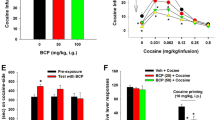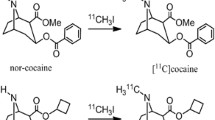Abstract
Butyrylcholinesterase (BChE) gene therapy is emerging as a promising concept for treatment of cocaine addiction. BChE levels after gene transfer can rise 1000-fold above those in untreated mice, making this enzyme the second most abundant plasma protein. For months or years, gene transfer of a BChE mutated into a cocaine hydrolase (CocH) can maintain enzyme levels that destroy cocaine within seconds after appearance in the blood stream, allowing little to reach the brain. Rapid enzyme action causes a sharp rise in plasma levels of two cocaine metabolites, benzoic acid (BA) and ecgonine methyl ester (EME), a smooth muscle relaxant that is mildly hypotensive and, at best, only weakly rewarding. The present study, utilizing Balb/c mice, tested reward effects and cardiovascular effects of administering EME and BA together at molar levels equivalent to those generated by a given dose of cocaine. Reward was evaluated by conditioned place preference. In this paradigm, cocaine (20 mg/kg) induced a robust positive response but the equivalent combined dose of EME + BA failed to induce either place preference or aversion. Likewise, mice that had undergone gene transfer with mouse CocH (mCocH) showed no place preference or aversion after repeated treatments with a near-lethal 80 mg/kg cocaine dose. Furthermore, a single administration of that same high cocaine dose failed to affect blood pressure as measured using the noninvasive tail-cuff method. These observations confirm that the drug metabolites generated after CocH gene transfer therapy are safe even after a dose of cocaine that would ordinarily be lethal.




Similar content being viewed by others
References
Anker JJ, Brimijoin S, Gao Y, Geng L, Zlebnik NE, Parks RJ, Carroll ME (2012) Cocaine hydrolase encoded in viral vector blocks the reinstatement of cocaine seeking in rats for 6 months. Biol Psychiatry 71:700–705
Balazs AB, Chen J, Hong CM, Rao DS, Yang L, Baltimore D (2012) Antibody-based protection against HIV infection by vectored immunoprophylaxis. Nature 481:81–84
Brimijoin S, Shen ML, Sun H (2002) Radiometric solvent-partitioning assay for screening cocaine hydrolases and measuring cocaine levels in milligram tissue samples. Anal Biochem 309:200–205
Brimijoin S, Orson F, Kosten TR, Kinsey B, Shen XY, White SJ, Gao Y (2013) Anti-cocaine antibody and butyrylcholinesterase-derived cocaine hydrolase exert cooperative effects on cocaine pharmacokinetics and cocaine-induced locomotor activity in mice. Chem Biol Interact 203:212–216
Carroll ME, Gao Y, Brimijoin S, Anker JJ (2011) Effects of cocaine hydrolase on cocaine self-administration under a PR schedule and during extended access (escalation) in rats. Psychopharmacology 213:817–829
Carroll ME, Zlebnik NE, Anker JJ, Kosten TR, Orson FM, Shen X, Kinsey B, Parks RJ, Gao Y, Brimijoin S (2012) Combined cocaine hydrolase gene transfer and anti-cocaine vaccine synergistically block cocaine-induced locomotion. PLoS One 7:e43536
Cunningham CL, Gremel CM, Groblewski PA (2006) Drug-induced conditioned place preference and aversion in mice. Nat Protoc 1:1662–1670
Eisener-Dorman AF, Grabowski-Boase L, Tarantino LM (2011) Cocaine locomotor activation, sensitization and place preference in six inbred strains of mice. Behav Brain Funct 7:29
Gao Y, Orson FM, Kinsey B, Kosten T, Brimijoin S (2010) The concept of pharmacologic cocaine interception as a treatment for drug abuse. Chem Biol Interact 187:421–424
Gao Y, Geng L, Orson F, Kinsey B, Kosten TR, Shen X, Brimijoin S (2013) Effects of anti-cocaine vaccine and viral gene transfer of cocaine hydrolase in mice on cocaine toxicity including motor strength and liver damage. Chem Biol Interact 203:208–211
Geng L, Gao Y, Chen X, Hou S, Zhan CG, Radic Z, Parks RJ, Russell SJ, Pham L, Brimijoin S (2013) Gene transfer of mutant mouse cholinesterase provides high lifetime expression and reduced cocaine responses with no evident toxicity. PLoS One 8:e67446
Itzhak Y, Martin JL (2002) Cocaine-induced conditioned place preference in mice: induction, extinction and reinstatement by related psychostimulants. Neuropsychopharmacology 26:130–134
Kurth CD, Monitto C, Albuquerque ML, Feuer P, Anday E, Shaw L (1993) Cocaine and its metabolites constrict cerebral arterioles in newborn pigs. J Pharmacol Exp Ther 265:587–591
Murthy V, Gao Y, Geng L, LeBrasseur N, White T, Brimijoin S (2014a) Preclinical studies on neurobehavioral and neuromuscular effects of cocaine hydrolase gene therapy in mice. J Mol Neurosci 53:409–416
Murthy V, Gao Y, Geng L, LeBrasseur NK, White TA, Parks RJ, Brimijoin S (2014b) Physiologic and metabolic safety of butyrylcholinesterase gene therapy in mice. Vaccine 32:4155–4162
Roux S, Froger C, Porsolt RD, Valverde O, Maldonado R (2003) Place preference test in rodents. Curr Protoc Neurosci Chapter 9, 9–15
Sun H, El Yazal J, Brimijoin S, Pang Y-P (2001) Predicted Michaelis–Menten complexes of cocaine-butyrylcholinesterase: engineering effective butyrylcholinesterase mutants for cocaine detoxification. J Biol Chem 276:9330–9336
Sun H, Shen M, Pang Y-P, Lockridge O, Brimijoin S (2002) Cocaine metabolism accelerated by a re-engineered human butyrylcholinesterase. J Pharmacol Exp Ther 302:710–716
Yang W, Xue L, Fang L, Chen X, Zhan CG (2010) Characterization of a high-activity mutant of human butyrylcholinesterase against (-)-cocaine. Chem Biol Interact 187:148–152
Zakusov VV, Kostochka LM, Skoldinov AP (1978) Effect of cocaine molecule fragments on the central nervous system. Biull Eksp Biol Med 86:435–438
Zheng F, Yang W, Ko MC, Liu J, Cho H, Gao D, Tong M, Tai HH, Woods JH, Zhan CG (2008) Most efficient cocaine hydrolase designed by virtual screening of transition states. J Am Chem Soc 130:12148–12155
Zlebnik NE, Brimijoin S, Gao Y, Saykao AT, Parks RJ, Carroll ME (2014) Long-term reduction of cocaine self-administration in rats treated with adenoviral vector-delivered cocaine hydrolase: evidence for enzymatic activity. Neuropsychopharmacology 39:1538–1546
Acknowledgments
This work was supported by the National Institute on Drug Abuse at the National Institutes of Health (grant nos. RO1DA23979 and D1DA31340).
Conflict of interest
The authors declare that they have no conflict of interest.
Author information
Authors and Affiliations
Corresponding author
Rights and permissions
About this article
Cite this article
Murthy, V., Geng, L., Gao, Y. et al. Reward and Toxicity of Cocaine Metabolites Generated by Cocaine Hydrolase. Cell Mol Neurobiol 35, 819–826 (2015). https://doi.org/10.1007/s10571-015-0175-9
Received:
Accepted:
Published:
Issue Date:
DOI: https://doi.org/10.1007/s10571-015-0175-9




